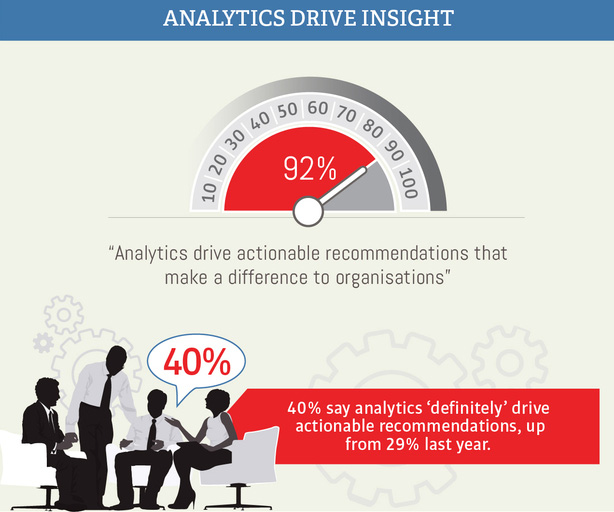Data-driven marketing offers you the opportunity to make your marketing campaigns run more effectively and efficiently, provided you use it in the right way.
More and more companies are using data-driven marketing. On the one hand this is because companies increasingly understand the opportunities that technologies offer, while those same technologies now seem mature enough to interpret data in the right way.
So, what is data-driven marketing?
With data-driven marketing you are able to collect, analyze and integrate data. You can use internal and external data of clients and past marketing campaigns to optimize future marketing campaigns.
You can gain insight into customer behavior and customer needs, allowing to focus even more on your customers. You don’t base your actions on your gut feeling but on the basis of demonstrable data.
Data that is often used:
- Collected customer data
- Google Analytics
- Social media
- Industry- and sectorinformation
Advantages of data-driven marketing
The most important advantage of data-driven marketing is that you will learn more and more about the behavior and needs of your target group and will be able to respond to them in a better way. By repeating the process the effectiveness only increases.
In addition, thanks to data-driven marketing you can communicate directly with your customers, because you know who they are, where they are and what needs they have.
Another advantage is that you will use your marketing budget more efficiently. When you have more data at hand, you are able to carry out more focused and personal marketing campaigns, so that you reach the right people. You will also see the returns on your investments more clearly in this way.

Econsultancy concluded on the basis of its own research among 1,000 marketers and analysts that data-driven marketing is profitable for companies. Of the respondents, 40% said that the compiled statistics gave them actionable recommendations. In the survey, respondents indicated the following growth and profit-related opportunities for data:
- 55% sees opportunities to optimize conversion rates
- 43% gains new customers thanks to data
- 42% managed to improve the marketing ROI
Foundation for success
The Big Data Survey 2017 by GoDataDriven surveyed 800 European professionals and for a vast majority of professionals a successful data strategy is the foundation for success.
It is striking that, although 9 out of 10 organizations in the study show a lot of potential in the use of data, these are mainly used only in dashboards for now. These act as the central hub for many marketers to clearly map the effect and result of their actions.
The professionals from Econsultancy’s research also indicated to what they think that the data should comply to:
- 56% says it should be possible to follow customer behavior across different devices and channels
- 53% thinks personalization and targeting is necessary
- 49% says that identifying valuable customer segments is important
- 44% wants to be able to evaluate the overall customer experience
- 43% wants to identify content interaction patterns and campaign responses
Please note that you should clearly know in advance about which data you want to collect and what you want to achieve with it. In this way, you are not only collecting data, but you will also commit to clear follow-up actions.
Econsultancy also states that the human factor must not be underestimated in data-driven marketing. For example, more and more companies are looking for analysts and are creating budget for this. 28% of the professionals in the survey indicated that they employ 5 or more data analysts who interpret the data in the right way.
Getting started
The first step is to determine your objectives to get started with data-driven marketin. Make a list of the most important problems you want to solve. For example, think about:
- Identifying your most valuable customers
- At which time of the buying process potential customers drop off
- Measuring customer satisfaction
- The effect of a marketing campaign
Now that it’s clear which data you want to collect, the next step is to take action. Determine which tools you want to use for data collection.
After that, it’s important to actually do something with the collected data, so make sure you have a plan on how you want to implement this data within your current processes and campaigns.
Examples of data-driven marketing
Below you will find a number of Dutch practical examples to give you insights into data-driven marketing for B2B companies.
Albert Heijn
 For the first time, Dutch supermarkets collect more than 1 billion euros in online sales in 2017 according to GfK market research estimates. The largest part of this is accounted for by Albert Heijn and Jumbo, which in 2016 already accounted for half a billion euros in online sales. They also have an incredible amount of valuable customer data.
For the first time, Dutch supermarkets collect more than 1 billion euros in online sales in 2017 according to GfK market research estimates. The largest part of this is accounted for by Albert Heijn and Jumbo, which in 2016 already accounted for half a billion euros in online sales. They also have an incredible amount of valuable customer data.
Albert Heijn is one of the supermarkets that works in a data-driven way. Amongst others, with the Appie app that was renewed earlier this year. In addition to useful functions such as voice recognition via Siri and a barcode scanner, Albert Heijn also uses the app to gain more insights into the user. Based on the data of a shopper’s loyalty card, the supermarket wants to make better personal offers but also automatically generate shopping lists with data that Albert Heijn already has. This could then be linked to the home delivery service for more efficient delivery routes.
Boon Edam
Boon Edam Netherlands is the global market leader in revolving doors and secure access products. One of their marketing objectives is informing and inspiring architects, the main target audience of the company.
 The goal of Boon Edam was to have 10,000 visitors on landing pages in the architect target audience within ten months using inbound marketing. First personas were created and then the different phases in the customer journey. After that, content was created that matched the top-5 questions that architects ask Boon Edam.
The goal of Boon Edam was to have 10,000 visitors on landing pages in the architect target audience within ten months using inbound marketing. First personas were created and then the different phases in the customer journey. After that, content was created that matched the top-5 questions that architects ask Boon Edam.
Ultimately, this marketing campaign led to 13,000 visitors and about 400 leads. According to Boon Edam the sales department can become even more personal and valuable, by responding better to the interests and needs of these leads by using technology. They know which content has been viewed by an architect and in which phase of the customer journey the person is.
Want to know more about this case? Marketing manager Henk Goede of Boon Edam Netherlands explains here, among other things, what their ideal view of the near future is.
Ricoh Netherlands
Ricoh Netherlands has a flowchart for promoting a consistent customer experience as a basis for their overall marketing strategy. In this flowchart they share content based on commercial intent and then link these to the general marketing objectives, says Senior Online Marketeer Ger Nijkamp indicates this in an interview.
 Ricoh Netherlands is the main sponsor of the tennis tournament in Rosmalen. Everyone who registers for the tournament as a visitor enters their marketing automation system. For each person they analyze to what extent the person is an interesting fit for the target marketing groups. Within Rico Netherlands these include ‘Online Collaboration’, ‘Mobile Printing’ and ‘Digital Digitizing’.
Ricoh Netherlands is the main sponsor of the tennis tournament in Rosmalen. Everyone who registers for the tournament as a visitor enters their marketing automation system. For each person they analyze to what extent the person is an interesting fit for the target marketing groups. Within Rico Netherlands these include ‘Online Collaboration’, ‘Mobile Printing’ and ‘Digital Digitizing’.
Individuals are classified per target market on the basis of personas and then content is offered based on the specific customer or buyer journey.
In conclusion
Different B2B industries can successfully apply data-driven marketing. It’s important to determine your marketing objectives in advance and what data you want to collect in order to realize them.
By subsequently working on your marketing campaigns and analyzing the data, you can make real changes. And by continually optimizing these processes, you not only have a better understanding of how to use your marketing budget and what returns it yields, but you will also provide an efficiency boost and you will have more insights into whether the assumptions you had beforehand actually match reality.
Are you already using data-driven marketing within your B2B company? Do you have any practical tips? Leave your comment below.
